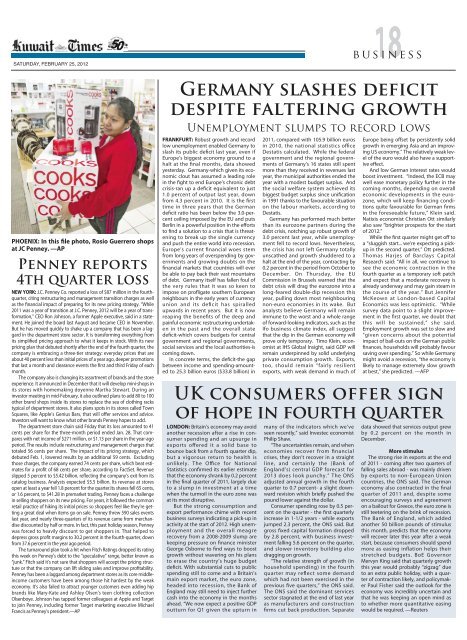Download - Kuwait Times
Download - Kuwait Times
Download - Kuwait Times
You also want an ePaper? Increase the reach of your titles
YUMPU automatically turns print PDFs into web optimized ePapers that Google loves.
SATURDAY, FEBRUARY 25, 2012<br />
PHOENIX: In this file photo, Rosio Guerrero shops<br />
at JC Penney. —AP<br />
Penney reports<br />
4th quarter loss<br />
NEW YORK: J.C. Penney Co. reported a loss of $87 million in the fourthquarter,<br />
citing restructuring and management transition charges as well<br />
as the financial impact of preparing for its new pricing strategy. “While<br />
2011 was a year of transition at J.C. Penney, 2012 will be a year of transformation,”<br />
CEO Ron Johnson, a former Apple executive, said in a statement.<br />
He joined the board last August and became CEO in November.<br />
But he has moved quickly to shake up a company that has been a laggard<br />
in the department store sector. It is transforming everything from<br />
its simplified pricing approach to what it keeps in stock. With its new<br />
pricing plan that debuted shortly after the end of the fourth quarter, the<br />
company is embracing a three-tier strategy: everyday prices that are<br />
about 40 percent less than initial prices of a year ago, deeper promotions<br />
that last a month and clearance events the first and third Friday of each<br />
month.<br />
The company also is changing its assortment of brands and the store<br />
experience. It announced in December that it will develop mini-shops in<br />
its stores with homemaking doyenne Martha Stewart. During an<br />
investor meeting in mid-February, it also outlined plans to add 80 to 100<br />
other brand shops inside its stores to replace the sea of clothing racks<br />
typical of department stores. It also plans spots in its stores called Town<br />
Squares, like Apple’s Genius Bars, that will offer services and advice.<br />
Investors will want to know what other brands Penney hopes to add.<br />
The department store chain said Friday that its loss amounted to 41<br />
cents per share for the three-month period ended Jan. 28. That compares<br />
with net income of $271 million, or $1.13 per share in the year-ago<br />
period. The results include restructuring and management charges that<br />
totaled 56 cents per share. The impact of its pricing strategy, which<br />
debuted Feb. 1, lowered results by an additional 59 cents. Excluding<br />
those charges, the company earned 74 cents per share, which beat estimates<br />
for a profit of 68 cents per share, according to FactSet. Revenue<br />
slipped 5 percent to $5.42 billion, reflecting the company’s exit from its<br />
catalog business. Analysts expected $5.5 billion. Its revenue at stores<br />
open at least a year fell 1.8 percent for the quarter.Its shares fell 65 cents,<br />
or 1.6 percent, to $41.28 in premarket trading. Penney faces a challenge<br />
in selling shoppers on its new pricing. For years, it followed the common<br />
retail practice of hiking its initial prices so shoppers feel like they’re getting<br />
a great deal when items go on sale. Penney threw 590 sales events<br />
last year, and nearly three-quarters of its revenue came from merchandise<br />
discounted by half or more. In fact, this past holiday season, Penney<br />
was forced to heavily discount to get shoppers in. That helped to<br />
depress gross profit margins to 30.2 percent in the fourth-quarter, down<br />
from 37.6 percent in the year ago period.<br />
The turnaround plan took a hit when Fitch Ratings dropped its rating<br />
this week on Penney’s debt to the “speculative” range, better known as<br />
“junk.” Fitch said it’s not sure that shoppers will accept the pricing structure<br />
or that the company can lift sliding sales and improve profitability.<br />
Penney has been a laggard among department stores as its core middleincome<br />
customers have been among those hit hardest by the weak<br />
economy. It’s also failed to attract younger customers even adding hip<br />
brands like Mary-Kate and Ashley Olsen’s teen clothing collection<br />
Olsenboye. Johnson has tapped former colleagues at Apple and Target<br />
to join Penney, including former Target marketing executive Michael<br />
Francis as Penney’s president.—AP<br />
FRANKFURT: Robust growth and record<br />
low unemployment enabled Germany to<br />
slash its public deficit last year, even if<br />
Europe’s biggest economy ground to a<br />
halt at the final months, data showed<br />
yesterday. Germany-which given its economic<br />
clout has assumed a leading role<br />
in the fight to end Europe’s chronic debt<br />
crisis-ran up a deficit equivalent to just<br />
1.0 percent of output last year, down<br />
from 4.3 percent in 2010. It is the first<br />
time in three years that the German<br />
deficit ratio has been below the 3.0-percent<br />
ceiling imposed by the EU and puts<br />
Berlin in a powerful position in the efforts<br />
to find a solution to a crisis that is threatening<br />
to break up the single currency<br />
and push the entire world into recession.<br />
Europe’s current financial woes stem<br />
from long years of overspending by governments<br />
and growing doubts on the<br />
financial markets that countries will ever<br />
be able to pay back their vast mountains<br />
of debt. Germany itself has fallen foul of<br />
the very rules that it was so keen to<br />
impose on profligate southern European<br />
neighbours in the early years of currency<br />
union and its deficit has spiralled<br />
upwards in recent years. But it is now<br />
reaping the benefits of the deep and<br />
painful economic restructuring undertaken<br />
in the past and the overall state<br />
deficit-which covers budgets for central<br />
government and regional governments,<br />
social services and the local authorities-is<br />
coming down.<br />
In concrete terms, the deficit-the gap<br />
between income and spending-amounted<br />
to 25.3 billion euros ($33.8 billion) in<br />
2011, compared with 105.9 billion euros<br />
in 2010, the national statistics office<br />
Destatis calculated. While the federal<br />
government and the regional governments<br />
of Germany’s 16 states still spent<br />
more than they received in revenues last<br />
year, the municipal authorities ended the<br />
year with a modest budget surplus. And<br />
the social welfare system achieved its<br />
biggest budget surplus since unification<br />
in 1991 thanks to the favourable situation<br />
on the labour markets, according to<br />
Destatis.<br />
Germany has performed much better<br />
than its eurozone partners during the<br />
debt crisis, notching up robust growth of<br />
3.0 percent last year, while unemployment<br />
fell to record lows. Nevertheless,<br />
the crisis has not left Germany totally<br />
unscathed and growth shuddered to a<br />
halt at the end of the year, contracting by<br />
0.2 percent in the period from October to<br />
December. On Thursday, the EU<br />
Commission in Brussels warned that the<br />
debt crisis will drag the eurozone into a<br />
long-feared double-dip recession this<br />
year, pulling down most neighbouring<br />
non-euro economies in its wake. But<br />
analysts believe Germany will remain<br />
immune to the worst and a whole range<br />
of forward-looking indicators, such as the<br />
Ifo business climate index, all suggest<br />
that the dip in the German economy will<br />
prove only temporary. Timo Klein, economist<br />
at IHS Global Insight, said GDP will<br />
remain underpinned by solid underlying<br />
private consumption growth. Exports,<br />
too, should remain “fairly resilient<br />
exports, with weak demand in much of<br />
business<br />
Germany slashes deficit<br />
despite faltering growth<br />
Unemployment slumps to record lows<br />
LONDON: Britain’s economy may avoid<br />
another recession after a rise in consumer<br />
spending and an upsurge in<br />
exports offered it a solid base to<br />
bounce back from a fourth quarter dip,<br />
but a vigorous return to health is<br />
unlikely. The Office for National<br />
Statistics confirmed its earlier estimate<br />
that the economy shrank by 0.2 percent<br />
in the final quarter of 2011, largely due<br />
to a slump in investment at a time<br />
when the turmoil in the euro zone was<br />
at its most disruptive.<br />
But the strong consumption and<br />
export performance chime with recent<br />
business surveys indicating a pick-up in<br />
activity at the start of 2012. High unemployment<br />
and the overall meagre<br />
recovery from a 2008-2009 slump are<br />
keeping pressure on finance minister<br />
George Osborne to find ways to boost<br />
growth without wavering on his plans<br />
to erase the country’s huge budget<br />
deficit. With substantial cuts to public<br />
spending still to come and a Britain’s<br />
main export market, the euro zone,<br />
headed into recession, the Bank of<br />
England may still need to inject further<br />
cash into the economy in the months<br />
ahead. “We now expect a positive GDP<br />
outturn for Q1 given the upturn in<br />
many of the indicators which we’ve<br />
seen recently,” said Investec economist<br />
Philip Shaw.<br />
“The uncertainties remain, and when<br />
economies recover from financial<br />
crises, they don’t recover in a straight<br />
line, and certainly the (Bank of<br />
England’s) central GDP forecast for<br />
2013 does look punchy.” The ONS<br />
adjusted annual growth in the fourth<br />
quarter to 0.7 percent- a slight downward<br />
revision which briefly pushed the<br />
pound lower against the dollar.<br />
Consumer spending rose by 0.5 percent<br />
on the quarter - the first quarterly<br />
increase in 1-1/2 years - while exports<br />
jumped 2.3 percent, the ONS said. But<br />
gross fixed capital formation dropped<br />
by 2.8 percent, with business investment<br />
falling 5.6 percent on the quarter,<br />
and slower inventory building also<br />
dragging on growth.<br />
“The relative strength of growth (in<br />
household spending) in the fourth<br />
quarter may reflect some demand<br />
which had not been exercised in the<br />
previous five quarters,” the ONS said.<br />
The ONS said the dominant services<br />
sector stagnated at the end of last year<br />
as manufacturers and construction<br />
firms cut back production. Separate<br />
Europe being offset by persistently solid<br />
growth in emerging Asia and an improving<br />
US economy.” The relatively weak level<br />
of the euro would also have a supportive<br />
effect.<br />
And low German interest rates would<br />
boost investment. “Indeed, the ECB may<br />
well ease monetary policy further in the<br />
coming months, depending on overall<br />
economic developments in the eurozone,<br />
which will keep financing conditions<br />
quite favourable for German firms<br />
in the foreseeable future,” Klein said.<br />
Natixis economist Christian Ott similarly<br />
also saw “brighter prospects for the start<br />
of 2012.”<br />
While the first quarter might get off to<br />
a “sluggish start... we’re expecting a pickup<br />
in the second quarter,” Ott predicted.<br />
Thomas Harjes of Barclays Capital<br />
Research said: “All in all, we continue to<br />
see the economic contraction in the<br />
fourth quarter as a temporary soft patch<br />
and expect that a moderate recovery is<br />
already underway and may gain steam in<br />
the course of the year.” But Jennifer<br />
McKeown at London-based Capital<br />
Economics was less optimistic. “While<br />
survey data point to a slight improvement<br />
in the first quarter, we doubt that<br />
this will be sustained,” she said.<br />
Employment growth was set to slow and<br />
“given concerns about the potential<br />
impact of bail-outs on the German public<br />
finances, households will probably favour<br />
saving over spending.” So while Germany<br />
might avoid a recession, “the economy is<br />
likely to manage extremely slow growth<br />
at best,” she predicted. —AFP<br />
UK consumers offer sign<br />
of hope in fourth quarter<br />
data showed that services output grew<br />
by 0.2 percent on the month in<br />
December.<br />
More stimulus<br />
The strong rise in exports at the end<br />
of 2011 - coming after two quarters of<br />
falling sales abroad - was mainly driven<br />
by exports to non-European Union<br />
countries, the ONS said. The German<br />
economy also contracted in the final<br />
quarter of 2011 and, despite some<br />
encouraging surveys and agreement<br />
on a bailout for Greece, the euro zone is<br />
still teetering on the brink of recession.<br />
The Bank of England, which added<br />
another 50 billion pounds of stimulus<br />
this month, predicts that the economy<br />
will recover later this year after a weak<br />
start, because consumers should spend<br />
more as easing inflation helps their<br />
stretched budgets. BoE Governor<br />
Mervyn King said that quarterly growth<br />
this year would probably “zigzag” due<br />
to an extra public holiday, with a quarter<br />
of contraction likely, and policymaker<br />
Paul Fisher said the outlook for the<br />
economy was incredibly uncertain and<br />
that he was keeping an open mind as<br />
to whether more quantitative easing<br />
would be required. —Reuters

















